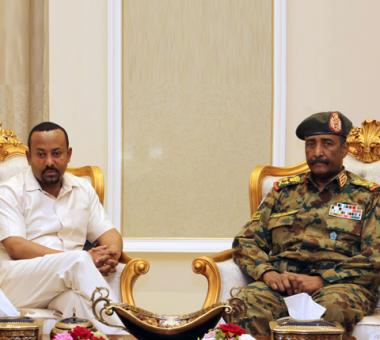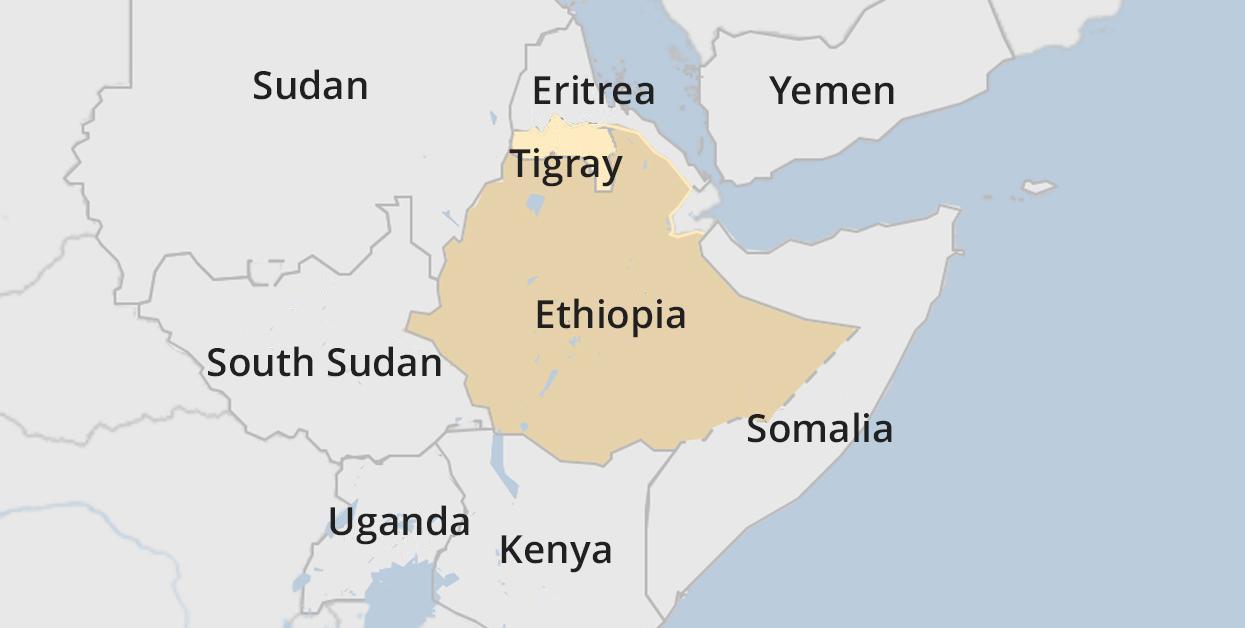Tension Dynamics between Sudan and Ethiopia
A perspective
The recent armed clashes between the Sudan and Ethiopia have once again highlighted issues of security and peace in the Horn of Africa and opened a new chapter of historic tensions on the borders. In this article, we present a picture of whether there is a possibility that tension will escalate into a conflict at the level of the two states and the sub-region of the Horn of Africa as a whole, based on a series of overlapping and interrelated changes and transformations, to consequently answer the following key question: Are these clashes an incidental situation or a prelude to a wider conflict?
by STRATEGIECS Team
- Publisher – STRATEGIECS
- Release Date – Feb 4, 2021

The recent border clashes between Sudan and Ethiopia, the latest in a series of decades-long ongoing tensions, may be seen as an incidental event that cannot amount to wider conflict, following the prevailing saying that border conflicts often do not lead to war.
However, a set of new variables lead us to believe that there is a great possibility for escalation in the current crisis, as it may quickly turn into a wider regional conflict. Analysing recent tensions requires a wide range of tools: The first is the understanding of the dynamics through which border conflict is affected by internal fighting in Ethiopia. The second is the expansion of the study to include the concerned parties and actors, which are Eritrea, the Tigray People’s Liberation Front, and the Amhara Group, as well as the parties to the conflict, i.e.; Sudan and Ethiopia. The third tool is the anatomizing of the nature of the conflict since it is based on natural resources -- land and water; hence, the effects of the Grand Ethiopian Renaissance Dam on the recent clashes can be studied. Linking and merging the previous factors would give a dynamic analysis that sheds light on the seriousness and complexity of the situation.
the demarcation of the Sudan-Ethiopia border, stretching more than 1,600 km, dates back to the Addis Ababa Agreement signed in 1902, when Sudan was still a British colony. After its independence it demanded 250 square kilometers of land controlled by Ethiopian farmers.
In 1996, Ethiopians occupied al-Fashqa, a region located within Sudan’s Al-Qadarif state, which border to the north the Ethiopian regional state of Amhara, spanning 600 square kilometers of fertile agricultural land. In 2008, however, Ethiopia acknowledged Sudan's legal boundary, and the latter allowed Ethiopian farmers to continue living there in a state of "soft borders."
Despite the settlement of the dispute, however, another more complex issue emerged. Dramatic shifts of events at home in Sudan and Ethiopia have brought the conflict to "square one". The rise of Ethiopian Prime Minister, Abiy Ahmed Ali, ended the Tigray Liberation Front’s (the first party in the 2008 compromise) seizure of power for decades, while Sudan witnessed a popular uprising that toppled former President, Omar al-Bashir (the other side of the 2008 compromise).
These changes have created new prospects for renewed conflict. Recently, the Sudanese Government seems less tolerant of the idea of "soft borders" and demands hard borders that prevent Ethiopians from farming and being within its territory. Meanwhile, the Abiy Ahmed government has retreated from previous understandings in line with the interests of major cotton and sesame farmers of the Amhara people, who regard agriculture to be an essential and traditional element in its social structure.
However, recent border clashes have coincided with infighting between Ethiopian forces and its allied groups on the one hand, and the TPLF on the other. In early December, Sudan accused Ethiopian armed groups of ambushing Sudanese forces along the border. Sudanese Information Minister Faisal Mohamed Saleh, speaking to Reuters, pointed the finger at Amhara military forces, after the TPLF and Ethiopian forces expanded their fighting to include disputed border areas.
At first glance, these wars may seem unconnected, but it is clear that internal conflicts and conflicts abroad in the Horn of Africa do intersect, and the complexities of the Tigray crisis and its dynamic interactions with geopolitics will, in one way or another, determine the future of the disputed areas.

Despite the announcement of the capture of Mekelle, the capital of Tigray, by Ethiopian Prime Minister Abiy Ahmed, the crisis does not appear to be over. The Front’s leaders are still on the run, with more than 20,000 troops, in addition to reservists from trained militias and a total of 250,000 armed farmers. TPLF has described its withdrawal from the capital without fighting as a tactical withdrawal, indicating its reliance on guerrilla tactics in which they have long-established experience.
In the midst of it, one of the survival strategies of the TPLF included expansion in Eritrea, taking advantage of its cultural and social ties there. The return of this strategy means that the conflict will take on a regional character. However, this may be at a time when the Front is now facing a tripartite coalition of the Ethiopian government, the Amhara military forces and Eritrea, the latter which shares with Abiy Ahmed the hostility towards the Front since the two parties signed in 2018 a peace agreement that ended decades of conflict. Therefore, the Front's ability to prolong the conflict depends on the Sudanese position regarding it.
Given that the only international border available to the TPLF is the border with Sudan - with the exception of its northern border with the hostile Eritrea - and despite Ethiopia's control of the equivalent portion of the border, controlling it is still almost impossible. To this day, refugees are pouring into Sudan, where their number has reached more than 60,000 Ethiopians in 2020, according to UNHCR. Addis Ababa has indicated its need for Sudan to control borders and prevent the escape of the TPLF fighters.
But Sudan does not share the hostility towards TPLF with the three aforementioned parties. The front was a partner in the border compromise in 2008, and Sudan, in turn, knows that the Amhara group's gains against the Front are an added value for them to assert their demands to control the disputed areas. Here, the following question may arise: If Sudan refuses to provide logistical support to the Front, will Ethiopia officially recognize its sovereignty over al-Fashqa?
It is not easy for Abiy Ahmed to accept this option, as he cannot ignore the interests of the Amhara in al-Fashaqa region., for they represent the second largest ethnic group in Ethiopia, and their support for him is considered necessary to ensure his continued rule, as well as their support for him in the fight against TPLF.
-ابي-احمد-السودان-واثيوبيا-توترات-1700x680.jpg)
Accordingly, the circumstances of the current conflict indicate that Sudan may not remain neutral. From the first day, Sudan accused the Ethiopian forces of supporting the Amhara group's fighters on its borders, and while the latter sought to preserve its agricultural and economic gains, Abiy Ahmed’s interest lies in forming a geographical depth that impedes the ability of TPLF to base itself in Sudanese territory. For its part, Sudan cannot cede its territory, otherwise, the various armed movements might understand this as a sign of weakness and abandonment from the government.
These dynamics may limit the rapprochement between Ethiopia and Sudan, and the two countries can easily return to the old approaches of the past relations of the eighties, when Ethiopia supported the Sudanese armed movements, and Sudan, in return, supported national groups, including the Tigray Liberation Front.
All things considered, the way in which the parties to the crisis interact internally and externally portends further escalation, especially since they have shown no restraint or reluctance to worsen the situation. As the round of talks between the two countries fails, accusations and aggravated speech prevail, and it seems unlikely that Sudan intends to withdraw from the areas it has controlled, at a time when Ethiopia is cautioning against impatience.
Another aspect of the conflict is worth addressing. If we look at the nature of the border disputes under study, we find that they are mostly about natural areas, meaning that these disputes are, in essence, conflict over land and resources. This perspective highlights a larger and more complex difference between the two countries. The clashes coincided with reports that negotiations on the Renaissance Dam, the file that exacerbates tensions between the two countries and threaten Egypt and Sudan's water supply.
There is several evidence that the two cases are linked, including the interview with Al-Arabiya on January 25, 2021, in which Sudanese Defense Minister Yasin Ibrahim linked the border dispute with Ethiopia to the Renaissance Dam negotiations. Also, Ethiopia's ambassador to the United Arab Emirates, Suleiman Dedefo, believes Sudan is waging a proxy war with Egypt's support.
In fact, a statement by the Egyptian government emphasized Cairo's support for Sudan's sovereignty over its territory, and there is a legal basis through which Egypt can intervene in border tensions, as the two countries are Bound by a joint defense treaty under the umbrella of the Arab League.
Understanding Egypt's position is very important to know the strategic implications of the conflict, at a time when the opportunity looms for it to obtain concessions from Ethiopia in the Renaissance Dam negotiations. If Cairo intervenes, the border tensions could turn into a long-term conflict. This may exacerbate insecurity in the border areas, including the Benishangul region, which is home to the Renaissance Dam and mainly witnessing a series of conflicts between armed groups.
Cairo, as such, could complicate Abiy Ahmed's calculations and hinder his recovery from the fighting with the TPLF, reflecting in his efforts to control the border and tighten the noose on the Front, not to mention the consequences of increasing the cost of security and construction for the Renaissance Dam.
It may be too early to say that a regional war is in development, for so far war is not an appropriate option for the two countries. There are common vital interests, development and economic programs are under way, a political future at stake, as well as a new US administration that is less responsive to conflicts and more inclined to diplomacy.
But merging past events and issues would pose significant risks to the Horn of Africa, as Ethiopia is facing internal fighting and insecurity and its peaceful options for dealing with its crises appear to be limited and unconvincing to Abiy Ahmed. Sudan may be forced to resort to war or proxy war and to support TPLF to ensure hard power in order to deter internal rebel groups and confront the Amhara groups on the border. This reality will prompt both Egypt and Eritrea to defend their interests in the region and support their collaborators. On the other hand, Cairo will seek to increase the cost of the Renaissance Dam and obtain concessions, and Eritrea will continue to support Abiy Ahmed in the face of the common enemy, the Tigray Liberation Front.
None of the parties show reluctance to ensure their security and to stabilize their demands. As a reminder, border disputes in the Horn of Africa have not always been simple, with Ethiopia fought two wars related to the disputed areas against Somalia in 1977 and Eritrea in 1998.

STRATEGIECS Team
Policy Analysis Team
 العربية
العربية